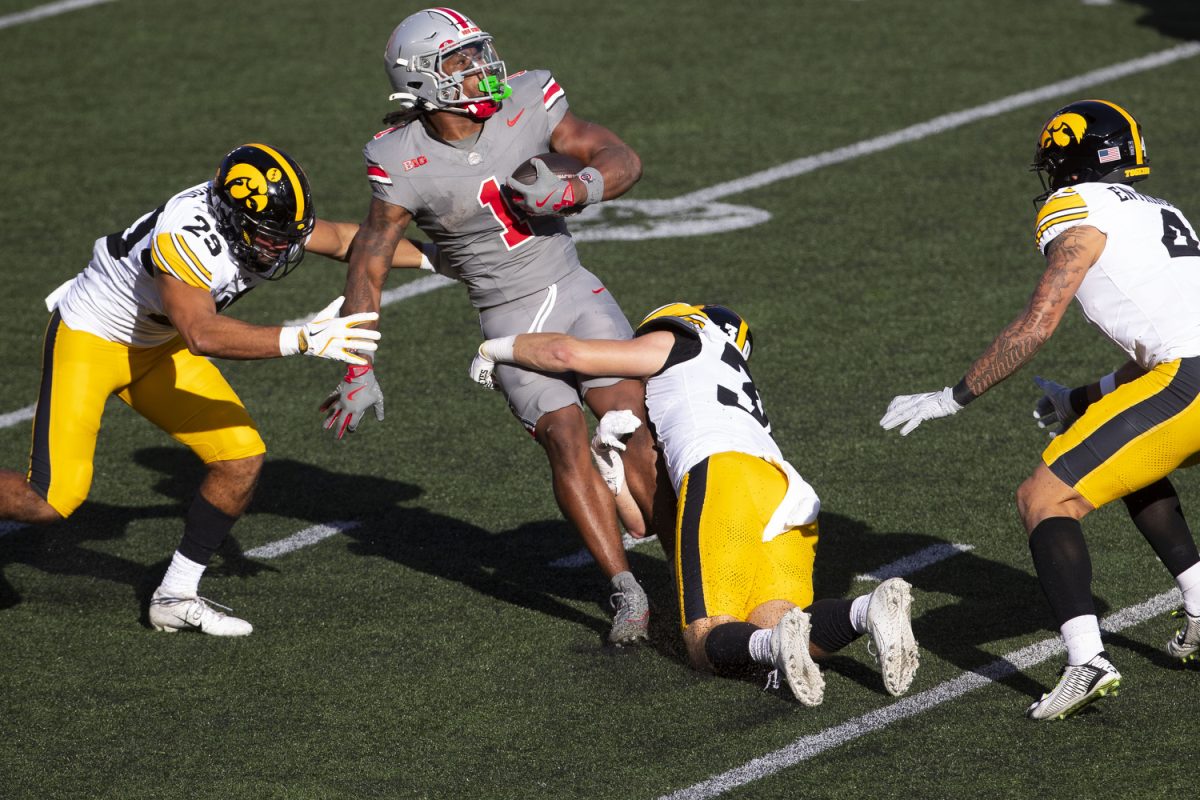1. Limiting the passing attack
For the second week in a row, the Hawkeyes will be up against a veteran quarterback in his first season at a new school. After four seasons at Mississippi State – where he set program records with 12,315 passing yards and 94 touchdowns – Will Rogers arrives at Washington with plenty of fanfare. After becoming the only quarterback in SEC history with over 1,000 completions, the 23-year-old Rogers has brought the same passing prowess to the Big Ten.
Standing at 6-foot-2 and 216 pounds, Rogers ranks second in the conference in passing yards, third in completion percentage, and fourth in passer rating as the Huskies sport the 16th-best passing offense in the FBS.
“He’s talented. He can make plays on his feet, he can make plays throwing the ball, and he’s not scared,” Iowa linebacker Nick Jackson said of Rogers. “You can tell he plays with extreme confidence and ownership of the offense. He can literally just put [the ball] in certain spots where he trusts his guys can go get it, and they definitely have the talent to do that.”
Armed with a pair of receivers – Denzel Boston and Giles Jackson – who have at least 35 catches and 400 yards apiece, the Huskies post another major threat in the air. I’ll be looking to see how the Hawkeyes respond, particularly with their personnel decisions. Will they go smaller and add safety Koen Entringer as an extra defender as opposed to another linebacker? Stay tuned.
2. Huskies embrace Big Ten ball
Despite the common perception of PAC-12 football relying on pass-first offenses, Washington isn’t afraid to put the ball on the ground early and often. Husky running back Jonah Coleman transferred from Arizona over the offseason and leads the team with 601 rushing yards and has all five of the Huskies’ ground scores this season. The third-year from Stockton, California, has size at 5-foot-9 and 229 pounds and isn’t afraid of contact.
“They run really hard,” Iowa defensive lineman Deontae Craig said of the Huskies. “If you don’t run your feet, you try to reach for the arm and they’ll just run right through you. It’ll be a great challenge for us.”
Stopping potent running backs hasn’t been an issue for the Hawkeyes, as they haven’t allowed a running back to post 100 yards in a game so far this season. Yet with the Huskies’ passing ability, Iowa might not be able to key in on the run and stack the box, giving Coleman the opportunity to have a day in Iowa City.
3. New-look 12 personnel
The Hawkeyes are also no stranger to running the ball, as evidenced by Kaleb Johnson’s 97 carries and 771 yards this season. Aside from his natural ability, part of Johnson’s success has derived from the Hawkeyes’ blocking in 12 personnel formations. This is where two tight ends line up with the offensive linemen and serve as extra blockers. Typically, Hawkeyes Luke Lachey and Addison Ostrenga have been on the field for these situations, but head coach Kirk Ferentz said Ostrenga will most likely not be in action on Saturday due to injury.
Ferentz said backup tight end Zach Ortwerth will be the first off the bench to fill in for Ostrenga, and the second-year will be put to the test against a Husky defense that has yielded 3.92 yards per carry this season.
4. Pacific to Kinnick
While Iowa’s Big Ten home opener against a former PAC-12 team might be odd for Hawkeye fans, the experience might be even more unusual for Washington players. An 11 a.m. Central kickoff equates to 9 a.m. Pacific, and to adjust to the time change, the Huskies will be flying out to Iowa on Thursday – a 5.5-hour flight from Seattle, according to Washington head coach Jedd Fisch. Even with extra time to prepare, Fisch knows that playing in Kinnick is a whole other adjustment.
“Our players don’t know how hard it is to play at Kinnick Stadium,” Fisch said at Big Ten Football Media Days in July. “We know how good of a defense it has, [Iowa defensive coordinator Phil] Parker is phenomenal at what he does.”
With 69,000-plus Hawkeye fans in attendance, the Huskies will have the crowd against them on Saturday. How they adjust to the time change and hostile environment will be critical for their chances of success in what should be a tight ballgame.
5. Penalty impact
As mentioned above, the roaring Kinnick crowd will do its best to distract the Washington players, who have been susceptible to flags so far this season. The Huskies rank second in the Big Ten with 45 penalties and 424 penalty yards. False starts could prove disastrous for Washington if it wants to build efficient drives.
Meanwhile, after an ugly first half in the season opener that saw six flags for the Hawkeyes, Iowa has become one of the most disciplined teams in the conference and in the nation with only 12 penalties charged against it. In a game that could be decided by less than a field goal, every yard gained or lost can make a difference. And with the stakes Hawkeyes have in this game – falling to .500 or moving up to 2-1 in Big Ten play – the yellow flags will have every fan holding their breath.



